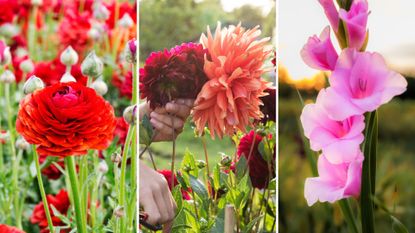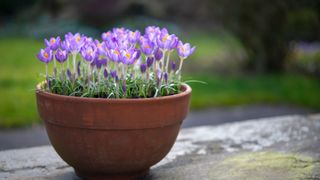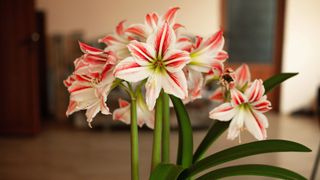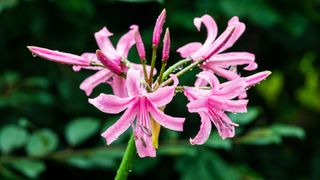Looking for garden inspiration? These plants - from colourful blooms to hearty veg - can be grown from bulbs and tubers
Find out how to keep your garden and green spaces full of life all year round


Whether it’s a bloom of colour to add cheer to any garden or flowerbed or a reliable source of homegrown veggies, bulbs and tubers help a wide range of plants weather harsh conditions to reproduce and grow at all points throughout the year.
Bulbs and tubers store their nutrition underground, and apart from being susceptible to rotting and over-watering, many can thrive being left alone to naturalise. When to plant bulbs depends on when they flower – as a general rule plant spring-flowering bulbs in autumn and summer-flowering bulbs in spring. Autumn bulbs and winter bulbs should be planted from late spring to summer.
With that in mind, just what can be grown from bulbs and tubers?
32 plants you can grow from bulbs or tubers
Lilies

A welcome flower celebrated for its fragrant blooms and elegant petals in a mix of pink and white colours, the lily plant generally comes in two main types: the Oriental lily and the Asiatic lily.
Grown from bulbs best planted between October and April, all types of lilies grow best in a position of full sun, ideally with their roots in rich and fairly moist, yet free-draining soil or compost.
Garlic

A flavourful ingredient that can really bring to life any number of our favourite comfort food dishes, even a true amateur gardener can grow a nice selection of garlic themselves. Garlic can be planted in autumn, usually between September to December, or it can be planted in spring, between January and late March.
To grow garlic, you’ll want to break the bulb into cloves, leaving the skin on, and placing them up to 4cm below the ground surface, 15cm apart from other cloves. Water your garlic during dry periods throughout the growing season, but stop watering completely during the last few weeks.
Sign up for the woman&home newsletter
Sign up to our free daily email for the latest royal and entertainment news, interesting opinion, expert advice on styling and beauty trends, and no-nonsense guides to the health and wellness questions you want answered.
Iris

With about 300 different species, the iris is one of the most visually striking plants in the garden. Whether grown in containers or in an open garden, irises are hardy and can tolerate both sun and shade. Iris bulbs are best planted between September and October, somewhere with a sunny position and well-drained soil.
If planted in the autumn, irises will be one of the first plants to bloom in the year and their perennial persistence can help provide colour year after year.
Tulips

For anyone who loves bursts of spring colours, you can’t go wrong with tulips. Best planted between October and November, tulip bulbs can also be planted in December if the climate is milder. Plant them in a sunny, sheltered spot and dig at least twice the depth of the bulb, pointed end up, around 5cm apart.
Calla Lily

A stunning flower often used in bouquets due to its exquisite colours, calla lilies can come in a variety of colours, including white, yellow, pink, orange, and even purple.
Best planted in spring, they should be grown in well-drained soil. To grow, dig a hole around 3-4 inches deep to give them roughly twice their height to grow, drop the bulb in, and cover it with soil. Make sure you place the bulb the right way up - the growing tips (also known as eyes) should be facing upwards.
After planting, water well so that the soil above the bulbs settles. When the bulbs are first planted, it’s important to water sparingly. Once the plants have a few leaves – usually after roughly two weeks - you can begin watering more generously.
Snowdrops

Usually a sign that spring is ready to, well, spring, snowdrops are gorgeous, dainty little flowers that add a delicate touch to any garden or flowerbed. The bulbs are best planted around August or September and will grow in most soil types, apart from permanently wet soil. They also thrive in areas that are partially shaded if planted outside in the garden.
Dahlia

For a true dose of drama, the dahlia reigns supreme. With vibrant colours in a diverse palette, including red, pink, orange, yellow, purple and white, dahlias enjoy a long bloom.
Best planted around springtime, plant dahlia tubers with the eyes facing upward. Cover them with a few inches of soil in a spot that gets good sunlight.
Daffodils

Daffodils – scientific name Narcissus – are one of the most recognisable and cheerful flowers that are very simple to grow.
If you’d love a sea of bright yellow petals brightening up your view year after year, daffodils can easily be grown in containers, beds and in the garden.
Plant daffodil bulbs in early autumn, ideally September, and potted bulbs in spring, and try to avoid overly soggy soil.
Chives

Chives add a nice dose of vitamin C to a number of dishes. With a flavour reminiscent of onions and garlic, the versatile herb can be added to soups, salads and stir-fries – and they’re easily grown as colourful plants either in the garden or in containers before being ready for the kitchen.
They’re best planted in the spring or autumn months, with summer temperatures proving too hot for them to truly flourish. When planting chive bulbs, use well-drained soil and plant them in a sunny spot.
Begonia

Coming in a range of red, pink, white, yellow, apricot, and salmon, flowering begonias have been a popular bedding plant since the Victorian era. A classic flower with a touch of exoticism thanks to its bright colours and large, ostentatious petals, tuberous begonias prefer bright, indirect light and well-draining soil. They can be grown indoors or outdoors.
Allium

Ornamental alliums are different to the Allium genus family which includes the likes of chives, garlic and onions. An ornamental allium, instead, offers a gorgeous statement flower for your garden, with these long-lasting, perennial flowers noted for a distinct purple, puffball flower. They grow best in milder climates, so spring or autumn. Too hot or too cold prove a difficult environment for the bulbs to thrive. When planting the bulbs, be sure they are in a spot that has plenty of sun and well-draining soil.
Crocus

A low-maintenance plant but one that offers a sea of colour when it bursts to life in a rainbow of white, yellow and purples, the crocus plant can be grown with relative ease.
Plant crocus bulbs between September and November or in spring, right after the last frost. The bulbs prefer full sun to partial shade and well-draining soil.
English Bluebells

There’s something breathtakingly beautiful about a quintessential English garden filled with hues of colourful wildflowers, like the English Bluebell.
The scientific name for these cheerful flowers is Hyacinthoides non-scripta and they typically flower in late spring. The bulbs should be planted between September and early December for the best results and they thrive in moist but free-draining soil in partial shade (which is why you typically find them growing wild around big, leafy trees).
Gladioli

Towering flowers which can come in a range of colours, including reds, pink, orange, yellow, purple and white, gladioli make a lovely addition to any garden or floral arrangement. If you’re considering growing your own, the bulbs are best planted in spring. If you are planting in pots, aim to have them in by March (should they be free from frost, such as in a greenhouse) or plant them directly into the ground around May.
Camassia

With brilliant and bold blues, plus a distinct star-like shape, camassia make for a statement addition to any garden. Native to North America, the Camassia genus of plants can sometimes be known as Indian hyacinth or quamash.
Camassia bulbs are best planted between September and November before the ground becomes too hard and thrive when the soil is moist but not waterlogged.
Canna Lily

Perfect for fans of bolder colours, canna plants produce a fiery display of red, orange and yellow flowers. The canna tubers are best planted between March and April and will tend to flower between June to October.
If not planting inside a pot somewhere where you can control the heat (such as a greenhouse), they should be planted in late April when it’s slightly warmer.
Freesia

Brightly coloured and long-lasting cut flowers, the freesia can be white, pink, blue or a glorious combination. Freesia can be grown in two ways, from either prepared corms or unprepared. The corms – similar to a bulb – can be heat treated to mimic the plant’s native South African conditions.
These prepared corms should be planted outside in April to flower in late summer or they can be grown in a cool greenhouse for early flowering. Unprepared freesia corms can be planted around September and should flower the following spring.
Astilbe

The feathery plume of the astilbe plant is a wonderful option for anyone looking to add more colour to their gardens but suffer from a lot of shade.
A unique flower, it’s sometimes referred to as false goat’s beard on account of its furry, ferny foliage. With lovely shades of pink, white, purple and red, it grows well in moist, boggy and shady patches.
The plant grows from a rhizome – a type of modified plant stem similar to a tuber – that’s best planted between September and mid-October.
Muscari

Also known as grape hyacinth, the muscari plant is native to Europe and Asia and is known for its cluster of small, bell-shaped flowers that can be a range of blue, purple, white or pink.
They are a welcome addition to any garden as they tend to draw in bees, who can become handy pollinators. The grape hyacinth bulbs are best planted in moist but well-drained soil or compost in autumn and watered well.
Pineapple lilies

Officially called Eucomis, the pineapple lily gets its name from the curious, tufted bloom which pokes out atop its tall stem and looks uncannily like the exotic fruit.
Plant the bulbs after all frost has passed as pineapple lilies need plenty of sun and warmth. If you’re planting directly in the ground and not in a pot, add extra grit to the soil to make sure it's thoroughly drained.
Crown Imperials

With a bright crown-like pattern in a mix of orange, yellow or red, the Crown Imperial (fritillaria imperialis) would make an eye-catching addition to any garden. Native to mountainous and hot regions including Turkey and Iran, the bulbs need to be planted into deep, well-drained soil, preferably somewhere with plenty of sun and warm conditions.
The effort is worth it as the plants can reach heights of up to four feet tall with big, bulbous flowers a statement maker.
Cyclamen

If you can’t bear looking out at a garden during the colder months to see little colour, you might consider planting cyclamen. These bright, cheerful plants can flower in late winter or early spring, when other flowers struggle to bloom. It’s important not to plant the tubers too deeply or they may not flower.
Persian buttercup

A romantic flower that offers a rose-like appearance, these delicate, colourful flowers would make a great addition to a garden – and could be grown to be cut and added for easy, impressive bouquets or centrepieces. The ideal time to plant the tubers is between mid-March and April, once the frost has gone from the soil, and in a spot which has partial shade.
Snake’s head fritillary

An intriguing checkerboard design across the pinky-purple petals gives this popular flower its name, as the drooping head and scaley pattern looks almost snakelike. Bulbs should be planted in September and October.
Plant the large bulbs deep enough to ensure flowering - with these unique flowers you want to put them around 30cm below the surface.
Siberian Squill

Officially the Scilla siberica, this is a flower that blooms a lot earlier than others, offering a pop of colour during the typically drab winter months.
The hardy bulb, native to the like of Siberia (hence the name), promises a brilliant bloom of blue-bell shaped flowers growing from slender stems that rise above the grass. Plant in early autumn, before the ground freezes over, alongside other spring bulbs in a full to part sunny location on well-drained soil.
Caladium

Grown from bulbs, caladium makes for a great houseplant as it is a relatively low fuss plant which offers large, colourful leaves. Indeed, it’s more common name is angel’s wings. You might commonly find them growing in hanging baskets and pots opposed to ground cover, and while they are beautifully bright, it must be stated that the plants can prove toxic to pets.
Amaryllis

A gorgeous plant known for its patterned red, pink and white leaves, the amaryllis plant is sometimes known as a hippeastrum and are given as gifts around Christmas time. Best planted in a pot indoors between October and January, the bulbs should flower within six to eight weeks. They thrive in well-lit spots with warmer temperatures.
Nerine

With a burst of brightly coloured pinks and whites, the delightful nerine typically flowers in autumn and offers a welcome spot of technicolour in the colder months. The best time to plant dry nerine bulbs is late summer. They can also be grown in pots.
Onions

There’s always room to jazz up a dish with a hint of onion, and to save you rushing out and buying one, why not grow your own? Onions planted from sets (small bulbs) should be planted in early spring. They should be planted somewhere with well-drained soil and at least six hours of direct sunlight per day.
Potatoes

Not the most beautiful to look at, but a versatile and useful vegetable to grow in your own garden, the potato is grown from a small tuber (known as seed potatoes). The official name of the potato is Solanum tuberosum (the more you know) and they are best planted between late March and late April.
If you want year-round potatoes, cold-stored seed potatoes can be planted in a large container kept inside a greenhouse or climate-controlled condition in July or early August.
Hyacinths

Fragrant spring-time favourites, hyacinths come in a selection of cheerful colours, including white, deep red, pink, purple and yellow. The luscious flower blooms in early spring if the bulbs are planted by early autumn. They thrive in areas with direct sunlight.
Peonies

Patience is a virtue, as they say, and peonies are proof of this. A slow grow plant, the gorgeous flower makes people wait for the final pay-off – which usually includes majestic, fragrant, and vivaciously-coloured petals of pink, red, cream and white.
All peony tubers require a moist but well-drained soil in full sun, and should be planted in autumn or spring depending on when you want the flowers to bloom.
The key to a good peony is to only plant the tuber no more than two inches below the soil’s surface – any deeper and the heavier flower won’t grow properly.

Jack Slater is not the Last Action Hero, but that's what comes up first when you Google him. Preferring a much more sedentary life, Jack gets his thrills by covering news, entertainment, celebrity, film and culture for woman&home, and other digital publications.
Having written for various print and online publications—ranging from national syndicates to niche magazines—Jack has written about nearly everything there is to write about, covering LGBTQ+ news, celebrity features, TV and film scoops, reviewing the latest theatre shows lighting up London’s West End and the most pressing of SEO based stories.
-
 Kate Garraway spreads Christmas joy with rainbow checkerboard dress and pink heels
Kate Garraway spreads Christmas joy with rainbow checkerboard dress and pink heelsKate Garraway's patterned jumper dress reminded us that fabulous festive outfits can also be so cosy and comfortable
By Emma Shacklock Published
-
 Drew Barrymore says she ‘struggled so much’ mentally with perimenopause, revealing her unexpected symptoms
Drew Barrymore says she ‘struggled so much’ mentally with perimenopause, revealing her unexpected symptomsDrew Barrymore has opened up about the mental toll perimenopause has taken on her, explaining the barrage of symptoms she's been hit with since entering this phase.
By Lucy Wigley Published